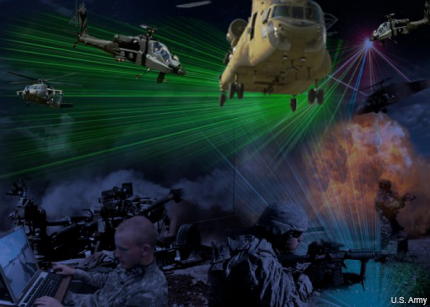'Live Synthetic' goes for the next level in simulation
The Army's holistic concept would blend live training with four types of simulations.

The Army, like the other military services, has long made simulations a part of training. They save money—a simulated cockpit costs less to “fly” than an actual jet—and have proved effective. They take the form of anything from systems that teach how to operate a Bradley Fighting Vehicle to computer-generated battle scenes with unpredictable enemies.
And if they could all be tied together, it could improve both the speed and efficiency of training the force.
That’s the idea behind the Army’s Future Holistic Training Environment-Live Synthetic. “Live Synth” entails a wide range of realistic battlespace scenarios that meld old-school field exercises with a range of computer modeled simulations, including familiar-but-updated small arms, armored vehicle and aircraft simulators. Full integration could be a decade away, but the initiative eventually would combine four simulation domains—Live, Virtual, Constructive and Gaming.
It will combine traditional training with the spectrum of simulations, including immersive augmented reality environments that provide a sense of hyper realism. All told the system seems destined to become a gamer/warrior paradise.
Which is what Live Synth managers and hardware and software designers are counting on; Live Synth plans to neatly leverage the familiarity and competence today’s recruits have with civilian video games like “Call of Duty.”
Key to the project’s development is a tool called Live Virtual Constructive-Integrative Architecture (LVC-IA). Lately awarded program-of-record status, it’s meant to determine optimal ways of blending parts of various simulations. Organizers hope eventually to add “Gaming” to the LVC triad.
Importantly, the pieces of Live Synth, being developed by the National Simulation Center (NSC), part of the U.S. Army Combined Arms Center at Fort Leavenworth, Kan., are customizable.
The evolution of training
Center director Col. John Janiszewski said in an interview that under Live Synth — and via LVC-IA — trainees will utilize LVC together or as stand-alone platforms. Similarly, one or more military branches can “cherry-pick” among mission-specific suites of scenarios. Various sized echelons can customize at will, using only elements needed to accomplish a task.
Janiszewski called Live Synth “our vision for how we see the training environment evolving.”
The concept will incorporate “Augmented Reality and collapse Virtual, Constructive, Gaming into a single synthetic environment … coupled to live (training) and integrated with the Army Training Information Systems,” he said. This one capability permits commanders to “fully plan, prepare, execute and assess training.”
Expected final-form advantages of LVC-G include less hardware, lower integration costs, increased agility to stay current, and considerable less operational personnel; all while “still maintaining a medium level of fidelity for home station and institutional training.”

A computer-generated enemy vehicle is seen burning on a mission command screen after being engaged by a Bradley Fighting Vehicle during training.
The other piece of this notional fusion is the electronic ITE (Integrated Training Environment). Driven by the FHTE-LS concept, Janiszewski said, the environment may be expanded as technology matures.
ITE was first fielded successfully in 2012 at Fort Hood, Texas, where a Brigade Combat Team used it to conduct multi-echelon training. The tool replicated “the complexities and rigor of the operational environment, and accurately stimulated the brigade's mission command information systems.” Concurrently, Janiszewski said, subordinate battalions and companies participated in the Live, Virtual, and Constructive domains. Since then, other installations have done likewise.
Much of the simulation center’s tasking is about technical complexities that crop up in the fusion process. But from tests conducted to date, it’s evident that when the kinks are worked out — access to the classified Secure IP Router network currently is lacking, for example — deployed troops will benefit.
Already, leaders have been encouraged by the results of limited integration of the tool with conventional live training.
Augment, not replace, reality
Janiszewski acknowledged that simulated training can’t replace the real thing, but it can improve training overall.
“There is no denying that live training is essential,” said, but soldiers and units will enter live training “at a higher readiness level after conducting a Live Synthetic-LS training exercise.”
In the Fort Hood example, the BCT unit was better able to replicate the complex operating environment with simulations. In effect, “they were able to create the 'fog of war' without all the safety risks,” Janiszewski said.
In one scenario, the unit managed to call in (simulated) artillery strikes near to where soldiers conducted live training, yielding challenging “indirect fire attack” battle drills.
Another LS benefit is that units were able to “fly” and exploit intelligence gathered from virtual unmanned aerial vehicles. “These troops were able to see the entire BCT area of operations and provide the commander with this valuable [streamed imagery] tool,” he said.

In a virtual environment, an IED simulator detonates as an opposing force soldier wait to ambush an approaching vehicle.
Janiszewski is also positive about blending aerial and armored-force training. “Tankers and aviators have been using computer simulations (and video-arcade resembling simulators) for many years,” while realizing the cost savings of simulations versus live training he said. “LS is a powerful collective training tool where aviators and ground soldiers from every echelon train together to hone their skills.”
The vision for future “full convergence” under Live-Synthetic training is home station and deployed forces engaging seamlessly in “one non-federated system” encapsulating all domains: land, space, sea, cyber and air.
Live Synthetic, in sum, will tie virtual, constructive, gaming and augmented reality simulations into a single synthetic environment; one that’s cloud-based, accessible world wide 24/7, and integratable with traditional live training.
There’s uncertainty over if or when the entire Live Synthetic initiative itself will attain program-of-record stature. But Janiszewski believes it might well become a services-wide training template.
He’s documenting requirements now, and next year expects to define them. Plans are to begin fielding evolved systems by fiscal 2022 and have them in place across the Army by 2025.



